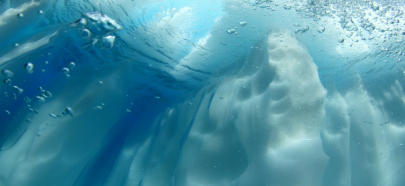Marine Life & Conservation
The Antarctic Peninsula
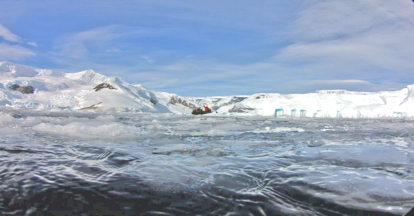
Think scuba diving, think polar-regions…
Maybe not the first thought for most divers when it comes to exploring the underwater world. But, put the chainsaws and ice blades aside. Polar diving doesn’t need to involve sawing a hole in the sea ice and keeping an ever-attentive eye on the “Jesus beam” (Walker, 2012) of light that illuminates your only route to the surface and the hot tea that’s hopefully waiting for you.
For the majority of people who have experienced polar diving – whether it is in the far north or the far south – their experiences have more likely involved an unassuming backward roll off the side of a Zodiac, a vast expanse of open surface above and unlimited supplies of hot tea upon surfacing. Polar diving programmes are now offered by a select number of expert expedition companies. These programmes have unwrapped the mystery of the polar seas for keen and proficient divers hardy enough to face extreme water temperatures between 3°C and a numbing -1.8°C.
So yes – it is cold, freezing cold. Yet reward is bountiful. Extreme cold often constitutes splendour in nature, and it is splendour on a grandiose scale. While exploring Eastern Greenland in the first half of the 19th century, William Scoresby wrote: “The whole exhibition is frequently a grand and interesting phantasmagoria.”
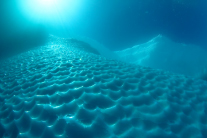 When you define phantasmagoria as “A sequence of real or imaginary images like that seen in a dream” (www.google.com), Scoresby’s description of a polar environment takes some beating. The landscapes, the ocean, the ice formations and the colours are extraordinary in both their vividness and their juxtaposing eeriness.
When you define phantasmagoria as “A sequence of real or imaginary images like that seen in a dream” (www.google.com), Scoresby’s description of a polar environment takes some beating. The landscapes, the ocean, the ice formations and the colours are extraordinary in both their vividness and their juxtaposing eeriness.
Many of these polar juxtapositions are best encountered along the Antarctic Peninsula. This 1500 kilometre spit of land stretches from the Antarctic mainland up towards the tip of South America, from which it is separated by one of histories most infamous stretches of ocean: The Drake Passage (McClintock et al, 2008). It is hard to find anywhere else on Earth where the beauty and raw, gnarly power of nature clash on such a tremendous scale as they do along the Antarctic Peninsula.
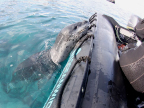 If you are one of the few people who take the rare opportunity to dive in this stunning part of the world, you can expect to begin a few dives surrounded by a blissful blue panorama that is nothing short of Scoresby’s phantasmagoria. Indeed it can be hard to fathom where you are and the overall reality of the situation when a flawless azure sky effortlessly drapes a glaciated mountain range, the blue delicately resonating off a mirrored sea surface. The only interruptions to this otherwise untouched sea are the seamless icebergs. Light emanates in every direction. Incorporate a bold Leopard seal (Hydrurga leptonyx) buzzing around the dive Zodiac and plumes of Humpback whale (Megaptera novaeangliae) blows in the distance and you have in front of you a genuine Antarctica pre-dive scene.
If you are one of the few people who take the rare opportunity to dive in this stunning part of the world, you can expect to begin a few dives surrounded by a blissful blue panorama that is nothing short of Scoresby’s phantasmagoria. Indeed it can be hard to fathom where you are and the overall reality of the situation when a flawless azure sky effortlessly drapes a glaciated mountain range, the blue delicately resonating off a mirrored sea surface. The only interruptions to this otherwise untouched sea are the seamless icebergs. Light emanates in every direction. Incorporate a bold Leopard seal (Hydrurga leptonyx) buzzing around the dive Zodiac and plumes of Humpback whale (Megaptera novaeangliae) blows in the distance and you have in front of you a genuine Antarctica pre-dive scene.
 Of course the splendour of extreme cold is just as real when the environment takes on a muted tone and a more dynamic character. And still it remains ever ethereal. The weather patterns along the Antarctic Peninsula are vast, variable and although not always inviting to a diver – or indeed any human – they are part of the Antarctic ‘deal’. After all, if you went to Antarctica and only experienced dream-like blue skies and calm seas would you not leave feeling somewhat short-changed? Being here is about experiencing the environment. To experience an environment you need to be amongst it, be part of it.
Of course the splendour of extreme cold is just as real when the environment takes on a muted tone and a more dynamic character. And still it remains ever ethereal. The weather patterns along the Antarctic Peninsula are vast, variable and although not always inviting to a diver – or indeed any human – they are part of the Antarctic ‘deal’. After all, if you went to Antarctica and only experienced dream-like blue skies and calm seas would you not leave feeling somewhat short-changed? Being here is about experiencing the environment. To experience an environment you need to be amongst it, be part of it.
So for all the dives you begin surrounded by azure skies, you will begin just as many surrounded by a foreboding sky so leaden with grey you will question your intentions. As you await the countdown to roll in, icy sea spray whips at the Zodiac and gusts of wind are unmistakeable in their polar origin. But this is when you feel amongst it, this is when you know you are part of it – this is when there is no doubt you are experiencing Antarctica.
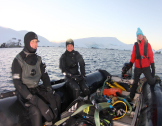 Before you have even ducked under the sea surface, Antarctica is all encompassing. When it comes to taking that first icy plunge, however, there is no mistaking the stark reality of Antarctica’s embrace: this is cold on another level. This is cold that your body doesn’t adjust to. This is cold that you put up with and you put up with it because it is your chance to be amongst Antarctica’s unique, archaic and gravely endangered marine ecosystems.
Before you have even ducked under the sea surface, Antarctica is all encompassing. When it comes to taking that first icy plunge, however, there is no mistaking the stark reality of Antarctica’s embrace: this is cold on another level. This is cold that your body doesn’t adjust to. This is cold that you put up with and you put up with it because it is your chance to be amongst Antarctica’s unique, archaic and gravely endangered marine ecosystems.
The shallow marine ecosystems of the Antarctic Peninsula are more akin to a deep-sea environment. The Antarctic Peninsula was once connected to South America before the continents split apart and the Drake Passage was created approximately 40 million years ago. One of the most ecologically important consequences of this split was the creation of a massive ocean current: The Antarctic Circumpolar Current (ACC). The ACC sweeps around the southern ocean and encircles Antarctica with such power that it is classed as the strongest current in the world (McClintock et al, 2008). It has essentially created an oceanographic barrier; a metaphorical fence separating Antarctica from the warmer sea and air temperatures further north. As a result the ecosystems of Antarctica have adapted to a specific suite of environmental conditions found nowhere else on Earth.
Whereas the ACC is separated from the majority of the continental mass of Antarctica, along the Western Antarctic Peninsula the topography of the ocean bottom allows the current to directly affect the ecosystems here (McClintock et al, 2008). The ACC effectively injects warmer, nutrient rich water onto Western Antarctic Peninsula shelf. The ecosystems surviving here are thus given the fundamental requirements to thrive and this is one reason diving here is such a joy. A second reason is the opportunity to encounter an ecosystem unlike any other. Along the Peninsula there has been an absence of durophagous (crushing) predators such as crabs and sharks. Perhaps things you want to see while diving? However, the absence of durophagous predators in Antarctica is a major reason why diving here is so unique. There are no thick-shelled organisms here because there has been no need for organisms to evolve such defences. Instead there are vibrant walls adorned with soft corals, tunicates, sponges and sea stars.
The colours are more flamboyant than anyone would anticipate for a polar environment. The underwater colours are certainly the artist’s palette of Antarctica. The warm colours that blaze across the seafloor enrich the white and blue light that reverberates in the sunshine on the surface. Even on a muted day, the underwater world continues to illuminate the environment. Here in lies the beauty and pleasure of diving in Antarctica. It is an opportunity to encounter an exclusive and magnificent part of this region, where surprises abound and the extreme cold is a hurdle thrown off the track.
It is the extreme cold, however, that has prevented durophagous predators from successfully inhabiting the Antarctic shelf waters for millions of years (Smith et al, 2011). The sea temperature has simply been too cold for their survival and the oceanographic barriers and distances are too great for their successful migration into the environment and their subsequent adaptation within it. Until now that is. The Antarctic Peninsula is one of the most rapidly warming regions on Earth. The extent of the warming and the potential and indeed present impacts are shocking. While air temperatures have increased by 5-6°C in the past 50 years, sea surface temperatures have increased by approximately 1°C (Smith et al, 2008). These may seem like small increases, but the reality is grave. King crabs (Neolithodes yaldwyni) and Spider crabs (Hyas araneus) have already been discovered along the Antarctic Peninsula. The slight warming of sea temperature here is facilitating their dispersal and survival.
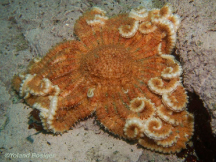 Influxes of crushing predators such as King crabs along the Antarctic Peninsula will have huge impacts. Organisms here have evolved without the need for strong skeletal defences. Of course this is now subject to extreme change as the overall fragility of the Antarctic Peninsula becomes ever more apparent. The gigantic sea stars that sprawl across the seafloor; the worms longer than humans; the prehistoric looking isopods; the ever-comical sea cucumbers…easy prey. The Antarctic Peninsula will cease to be the world’s most unique marine environment as temperatures continue to rise and predators that have otherwise been absent for millions of years become a common and dominating sight.
Influxes of crushing predators such as King crabs along the Antarctic Peninsula will have huge impacts. Organisms here have evolved without the need for strong skeletal defences. Of course this is now subject to extreme change as the overall fragility of the Antarctic Peninsula becomes ever more apparent. The gigantic sea stars that sprawl across the seafloor; the worms longer than humans; the prehistoric looking isopods; the ever-comical sea cucumbers…easy prey. The Antarctic Peninsula will cease to be the world’s most unique marine environment as temperatures continue to rise and predators that have otherwise been absent for millions of years become a common and dominating sight.
The invasion of durophagous predators is of course just one of a number of spiralling changes occurring as a result of regional warming along the Antarctic Peninsula. The ecosystem regimes that characterise Antarctica are changing and they are not changing for the better. Losing the charismatic invertebrates is a shame for divers hoping to explore the wonders of the Antarctic marine world, but for the overall ocean there is so much more at stake.
Every single year scientists are witnessing the winter sea ice dwindling along the Antarctic Peninsula: both the area covered by the ice and the number of days of ice cover is diminishing. On top of this glaciers are retreating and ice shelves are collapsing. While exploring the Antarctic Peninsula you will more than likely hear the thunderous crack of ice calving off the face of a glacier – a sound like no other; it embodies depth in a way thunder can merely mimic. There is no mistaking this sound and it is becoming a regular alarm warning us as to the fate of the Antarctic Peninsula.
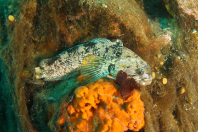 The sea ice in particular is the lifeblood of the Antarctic Peninsula marine ecosystem. Its demise is having an impact at every level of the food web, from the microscopic phytoplankton all the way through to the apex predators. Sea ice cover has reduced by 90 days per year in the past 50 years (Schofield, 2010) and with every day that is lost the entire ecosystem regime becomes under increasing threat. How this regime is impacted is multifaceted and complex. Antarctica is a treasure trove of large charismatic marine animals. The seals, the penguins and whales of Antarctica are recognised by many people worldwide. They are certainly a major reason many people brave crossing the notoriously stormy seas of the Drake Passage. Witnessing a Humpback whale mother and calf duo drifting between the impressive sheer mountain faces of the Lemaire Channel, or coming face to face with an overly jealous Leopard seal as it sets its large authoritarian head on the side of your zodiac and thoroughly stares you down, are moments that make stories that will last a lifetime of dinner parties.
The sea ice in particular is the lifeblood of the Antarctic Peninsula marine ecosystem. Its demise is having an impact at every level of the food web, from the microscopic phytoplankton all the way through to the apex predators. Sea ice cover has reduced by 90 days per year in the past 50 years (Schofield, 2010) and with every day that is lost the entire ecosystem regime becomes under increasing threat. How this regime is impacted is multifaceted and complex. Antarctica is a treasure trove of large charismatic marine animals. The seals, the penguins and whales of Antarctica are recognised by many people worldwide. They are certainly a major reason many people brave crossing the notoriously stormy seas of the Drake Passage. Witnessing a Humpback whale mother and calf duo drifting between the impressive sheer mountain faces of the Lemaire Channel, or coming face to face with an overly jealous Leopard seal as it sets its large authoritarian head on the side of your zodiac and thoroughly stares you down, are moments that make stories that will last a lifetime of dinner parties.
One of the most entertaining tales to tell, albeit a slightly morbid one, is that of penguins under chase. Gentoo penguins (Pygoscelis papua) are currently found in large numbers throughout the northern Antarctic Peninsula. They are one of a few species of penguin that will porpoise through the water while travelling; a behavior believed to relate to energy efficiency when moving through water while simultaneously managing to breathe (Davies, 2003). The regular flash of black and white is a delight. Little do the penguins know that as they porpoise towards their onshore colony, a Leopard seal awaits. An observant guide will see what is occurring and alert you to the drama that is about to unfold.
A penguin firework is a worthy description! A sudden burst of black and white sparks radiate in every direction when the penguins spot the seal. The neat raft instantly becomes a frenzied plume of penguins on the dash. If one penguin happens not to be the brightest or quickest spark then its chances of ever reaching the colony are slim. On top of this already impressive display, the Leopard seals are not modest when it comes to relishing a successful penguin hunt. Slapping and thrashing the unfortunate penguin on the surface, the Leopard seal skins and de-feathers its catch. The seemingly brash nature of these seals means they are often unperturbed by a boat full of dumbfounded, wet-weather gear clad tourists eagerly snapping away in an attempt to capture the spray of skin and blood (an image that is best served to your dinner guests after the meal). Whether this is nature at its finest or vilest is at the discretion of each enthralled individual. Either way, there is no denying this is nature as it should be. With air and sea temperatures continuing to rise markedly in this part of the world, such “as nature intended” events will come crashing down as the intricate and archaic food web unfurls into a bleak future.
We know the future of the Antarctic Peninsula entails further losses of sea ice. We know that as the sea ice continues to diminish the entire food web hangs in the balance. One tiny organism can put the severity and pervasiveness of this threat into perspective. If sea ice can be described as the lifeblood of the Antarctic Peninsula marine ecosystem, then Antarctic krill (Euphausia superba) can be described as the lynchpin. Krill is a shrimp like crustacean measuring little over 6 centimetres and with losses of sea ice krill numbers are crashing. Without krill there would be no Leopard seals, no Gentoo penguin fireworks and no unique diving opportunities. Sitting seemingly unobtrusively near the base of the Antarctic food web, krill is in effect one of the largest sources of protein on earth.
The krill itself feeds upon phytoplankton and as a phytoplankton feeder krill is a relatively large organism. In the majority of marine food webs there are a number of steps between microscopic phytoplankton and a 6 centimetre long crustacean. With each step upwards in a food web, the amount of energy transferred to the higher organism is reduced. This is due to a high percentage of energy consumed at each level being utilised in metabolic processes. Therefore, being just one step above phytoplankton in the food web makes krill an energy rich organism. Couple energy richness with the fact krill can be found in swarms totalling 2 millions tonnes and covering an area up to 450km2 (http://www.coolantarctica.com), the fact that these tiny creatures can sustain the Antarctic Peninsula ecosystem becomes palpable.
You may spot a swarm of krill while sailing through the impressive Antarctic landscape, the giveaway being a pink tinged area of water. If your voyage includes visiting penguin colonies onshore you will be greeted with a much more unambiguous giveaway: a pungent fishy krill smell emanating from the pink penguin poo spattered throughout the colony. Krill is the primary food source of Gentoo, Chinstrap (Pygoscelis antarcticus) and Adélie (Pygoscelis adeliae) penguins – all species inhabiting the Antarctic Peninsula and regularly spotted during summer cruises – and alarming population declines in the latter two species are thought to be primarily related to declines in both sea ice and krill (www.sciencedaily.com). At the South Shetland Islands on the northern tip of the Antarctic Peninsula, Chinstrap and Adélie penguin numbers have declined by over 50% in the past 30 years (Trivelpiece et al, 2010).
This is where the importance of both sea ice and krill – the lifeblood and the lynchpin –comes to the fore. Without sea ice, krill cannot reproduce successfully. In effect the sea ice acts as a nursery for krill larvae, providing good shelter from predators and a rich source of food thanks to the abundance of phytoplankton found underneath the sea ice (Daly, 1990). If the current rate of warming continues along the Antarctic Peninsula then winter sea ice will fail to form and krill biomass will reduce. Couple this with the current fishing pressure on krill as nations race to exploit this apparent health product (you may have spotted krill-oil tables appearing on the shelves of your local health store?) and the threat of the krill population crashing becomes ever more likely.
One recent study found krill abundance has reduced by 80% since 1970 (Trivelpeice et al, 2010) and the knock on effects are undeniably being seen in the populations of Chinstrap and Adélie penguins as well as throughout the Antarctic Peninsula ecosystem. Gentoo populations are one of the few species currently coping with the changes. This has been attributed to Gentoo penguins being an ice-avoiding penguin (avoids ice by breeding on ice-free beaches/shores and spending the majority of its time at sea foraging) as well as having life-history traits – including reaching sexual maturity at a young age and having a “high reproductive output” – making this species successful at adapting to a changing environment (Pistorius et al, 2010). Whether the Gentoo penguins continue to tolerate the severity of these changes remains to be seen. It is unlikely.
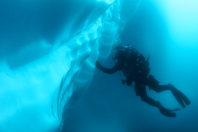 The future of the Antarctic Peninsula ecosystem is evidently reliant on krill, with penguins acting as a major indicator as to the current impacts of the loss of both sea ice and krill. We know krill sustains the entire ecosystem and its importance permeates throughout the food web. Crabeater seals, Fur seals, Weddell seals, Humpback whales, Minke whales, Southern Right whales, Skuas and Petrels are only a few of the species reliant on krill. Even Blue whales (Balaenoptera musculus) feed on krill. An organism weighing little over 1 gram is sustaining a whale that weighs on average over 200 tons. Absolutely nobody can deny the future is grave if krill isn’t a part of it. After all, without a lynchpin the wheels fall off and everything comes crashing down.
The future of the Antarctic Peninsula ecosystem is evidently reliant on krill, with penguins acting as a major indicator as to the current impacts of the loss of both sea ice and krill. We know krill sustains the entire ecosystem and its importance permeates throughout the food web. Crabeater seals, Fur seals, Weddell seals, Humpback whales, Minke whales, Southern Right whales, Skuas and Petrels are only a few of the species reliant on krill. Even Blue whales (Balaenoptera musculus) feed on krill. An organism weighing little over 1 gram is sustaining a whale that weighs on average over 200 tons. Absolutely nobody can deny the future is grave if krill isn’t a part of it. After all, without a lynchpin the wheels fall off and everything comes crashing down.
Whether you are observing the Antarctic Peninsula on the whole or at a more intimate level, this is an inspiring and moving place on every level. Being amongst this stately and distinctive environment is a pleasure, even if your body is encapsulated by cold as you study the marine invertebrates illuminating an underwater wall or you’re witnessing the gory yet enthralling spectacle of a Leopard seal skinning a penguin. Unfortunately it is a pleasure becoming ever more of a chore for the environment to support, because in reality, the wheels are falling off and it is crashing down.
For polar diving programmes check www.oceanwide-expeditions.com.
Main Photos by Jerry Sutton
Cushion star and Sun star by Yoland Bosiger
References for article
Daly, K.L, 1990. Overwintering development, growth, and feeding of larval Euphausia superba in the Antarctic marginal ice zone. Limnology and Oceanography, vol. 35, no. 7, pp. 1564 – 1576.
Davies, L.S, 2003. The Penguins. London: A & C Black.
McClintock, J, Ducklow, H, Fraser, W, 2008. Ecological Responses to Climate Change on the Antarctic Peninsula. American Scientist, July-August, 302-310.
PISTORIUS, P.A., HUIN, N. & CROFTS, S. 2010. Population change and resilience in Gentoo Penguins Pygoscelis papua at the Falkland Islands. Marine Ornithology, vol. 38, pp. 49–53.
Schofield, O et al, 2010. How Do Polar Marine Ecosystems Respond to Rapid Climate Change? Science, vol.328, no. 5985, pp. 1520-1523.
Scoresby, W., Jr. 1823. Journal of a Voyage to the Northern Whale Fishery; including Researches and Discoveries on the Eastern Coast of Greenland, made in the summer of 1822, in the Ship Baffin of Liverpool. Edinburgh: Archibald Constable and Co.
Smith, CR et al, 2011. A large population of king crabs in Palmer Deep on the west Antarctic Peninsula shelf and potential invasive impacts. Proceedings of the Royal Society, vol. 279, no. 1730, pp. 1017-1026.
Trivelpiece, W.Z, 2010. Variability in krill biomass links harvesting and climate warming to penguin population changes in Antarctica. PNAS, vol. 108, no. 18, pp. 7625 – 7628.
Walker, G, 2012. Antarctica: An Intimate Portrait of the World’s most Mysterious Continent. UK: Bloomsbury Publishing.
Web References
Cool Antarctica, pictures of Antarctica, information and travel guide . [ONLINE] Available at: http://www.coolantarctica.com. [Accessed 05 July 2013].
Diving in Antarctica|Underwater Photography Guide. [ONLINE] Available at: http://www.uwphotographyguide.com/antarctica-diving. [Accessed 30 June 2013].
Google, Google Definitions. [ONLINE] Available at: www.google.com. [Accessed 07 June 2013].
Science Daily, Science News, Changing Climate, Not Tourism, Seems to Be Driving Decline in Chinstrap-Penguin Populations. [ONLINE] Available at: http://www.sciencedaily.com/releases/2012/11/121114113805.htm. [Accessed 05 July 2013].
Marine Life & Conservation
Shark Trust launches Oceanic 31 Shark Art Auction

 After a two-year tour of UK art galleries, community spaces and aquariums, the Shark Trust’s acclaimed Oceanic31 exhibition takes its final bow at the Royal Geographical Society later this month. And the unique collection of artwork, depicting 31 species of oceanic sharks and rays, donated by 31 artists, is now open for bids from art lovers and shark enthusiasts. The online auction, launched today, will close on the 7th December at 8pm (BST). The money raised will support the Shark Trust Oceanics Programme.
After a two-year tour of UK art galleries, community spaces and aquariums, the Shark Trust’s acclaimed Oceanic31 exhibition takes its final bow at the Royal Geographical Society later this month. And the unique collection of artwork, depicting 31 species of oceanic sharks and rays, donated by 31 artists, is now open for bids from art lovers and shark enthusiasts. The online auction, launched today, will close on the 7th December at 8pm (BST). The money raised will support the Shark Trust Oceanics Programme.
People can now bid on 27 of the artworks by visiting this website:
https://superstars-auctions.com/sharktrustauction
It is a chance to own a beautiful piece of original art and to support the Shark Trust. The timing of the auction also means that these would make a very special Christmas gift for any shark-lover.
- Bigeye Thresher Shark by Janina Rossiter
- Carcharodon carcharias by Jimmy Higgs
- Croc VR 2030 by Tom Mead
- Oceanic Whitetip by ATM
- Silky Street by ScapaJoe
The diversity of pieces mirrors that of the sharks and rays they represent. You can bid on paintings, digital creations, sculptures, mixed media and more. You can pick your favourite artist or species of shark. Or you can select the perfect artwork to make a statement in your home or office. Whichever you choose, you will be supporting the work to protect these amazing animals.
One of the pieces of art has been selected to be auctioned live by Steve Backshall at the For the Love of Sharks event at the Royal Geographical Society in London on the 29th November. In addition to this, two further pieces will be raffled at this event, giving people a chance to win an incredible piece of shark art. For the Love of Sharks is the Shark Trust’s flagship evening. A night to celebrate sharks. Steve Backshall is the headline speaker at this event that will see other prominent shark advocates join him on stage.
Tickets for the event can be snapped up here:
https://thesharktrust.org.uk/Event/flos24
Those that would like to see the Oceanic 31 exhibition have one final chance. It is being displayed at the Pavilion at the Royal Geographic Society from 26th November until the 7th December. Entry is free.
Find out more here:
https://www.rgs.org/events/upcoming-events/oceanic-31
Paul Cox, Shark Trust CEO, Said “This exhibition has given us the opportunity to reach out to a new audience. And inspire more people with the wonderful sharks and rays on which our Big Shark Pledge campaign is based. We are immensely grateful to the 31 artists who have worked so hard to create these works.”
Bid for your favourite Oceanic 31 artwork here:
https://superstars-auctions.com/sharktrustauction
Banner Image: Smooth Hammerhead by Alicia Hayden
Marine Life & Conservation
Meet Steve Backshall in the Bite-Back Prize Draw

Until 28 November, prizes worth a massive £10,000 – including experiences, products and tuition – feature in a line-up of items that can be won for £5 in an online prize draw to celebrate Bite-Back Shark & Marine Conservation’s 20th anniversary and help generate crucial funds for the future.
Top of the list of prizes is the chance to spend time with adventurer and wildlife expert Steve Backshall, a workout session with Nat Geo star Aldo Kane, a kayaking trip alongside white-water expert and diver Sal Montgomery and a Zoom call with ‘shark whisperer’ Cristina Zenato.
On top of that, some of the most admired companies in the diving and scuba industry have been quick to support the charity with fabulous prizes that make the £5 ticket price worth more than just a flutter.
Master Liveaboards, BSAC, Midlands Diving Chamber, Go Freediving and Blue Shark Snorkel have all generously donated experience prizes, while celebrated photographer Alex Mustard has donated a print and artists Scott Gleed and Olivier Leger have donated a sculpture and illustration to help boost the fundraising pot.
Fourth Element has donated Ocean Positive gear and LA watch company Nodus has gifted the charity a stunning dive watch. For land lovers, the charity has included a five star London hotel stay at Bankside Hotel plus a family visit to Longleat Safari Park in the roster of prizes.
Campaign director for Bite-Back, Graham Buckingham, said: “We’ve been overwhelmed with support from companies and individuals that we truly admire and who have supported us on our 20 year journey and we’re truly grateful to them all. While we feel incredibly proud of our achievements over the past two decades – and we are super excited about the next chapter – this prize draw isn’t a vanity project. It represents a real lifeline to our work and important advancements in the global protection of sharks. So we hope divers, dive clubs and even bargain hunters grab some tickets to make this a massive success.”
The charity hopes that the prize draw will generate crucial funds to launch a brand new, ground-breaking, campaign to enrol the public and increase support for the protection of sharks around the world.
To enter the competition visit www.bite-back.com/prizedraw. The prize winners will be announced on 1 December 2024.
-

 News1 month ago
News1 month agoIconic SS United States to become the World’s Largest Artificial Reef
-

 Blogs3 months ago
Blogs3 months agoNovoScuba’s Game-Changing Approach for Dive Store Owners: WE PAY YOU!
-

 News2 months ago
News2 months agoBook Review – 52 Assignments: Underwater Photography
-

 Gear News2 months ago
Gear News2 months agoDYNAMICNORD – New German diving brand enters the British market
-

 News2 months ago
News2 months agoExploring Cenote El Pit: A Diver’s Dream
-

 Gear News2 months ago
Gear News2 months agoTry BARE drysuits (and maybe even win one!) this Friday with Sea & Sea at North West Dive Fest
-

 News3 months ago
News3 months agoComing Soon – 52 Assignments
-

 News3 months ago
News3 months agoSave £200 per person per week at Pole Pole Lodge with Dive Worldwide



